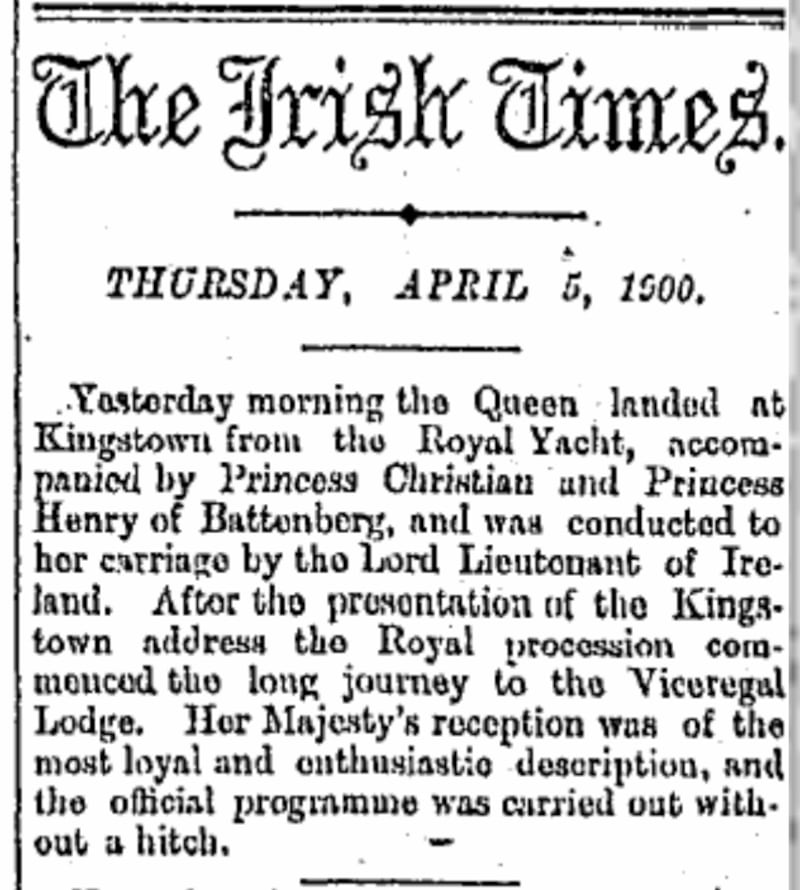Coverage of the British royal family always revels in hyperbole and a deficiency of perspective, as we are now seeing as royal “watchers” anticipate the birth of Meghan Markle’s child with Prince Harry. It’s a good time to remember a royal visit nearly 120 years ago, when Queen Victoria made her fourth and final visit to Ireland in 1900.
Queen Victoria had previously visited Ireland in 1849, in the wake of the Famine. In honour of that visit, Cobh in Cork was renamed Queenstown until after Irish independence. As a young woman she visited Killarney. Ladies View in Killarney National Park was subsequently named after her ladies-in-waiting when she visited Kerry again in 1861 and stayed at Muckross House.
While the reporting style in the newspaper was relatively reserved at the time, all of that went out the window when the queen came to town. The lead report on Thursday, April 5th, was gushing, beginning: "The scene which Dublin presented yesterday will live long in the memory of those who witnessed it. In her long and glorious reign Her Majesty the Queen-Empress has been the recipient of many popular ovations which from a purely spectacular point of view might perhaps have eclipsed that of yesterday, but we venture to think that for genuine and spontaneous enthusiasm exhibited at every point of her long route from the prosperous and loyal Township from which she started to her destination in the Phoenix Park she has never witnessed a more enthusiastic expression of real affection for her person and attachment to her Throne."

Excellent woman
It went on, “The lavish, yet withal eminently tasteful, decoration which graced every point of vantage found a suitable and significant setting in the hundreds of thousands of her loyal subjects, who continuously lined her route, and greeted her with one unbroken shout of joyous acclaim. Every expression which affection could inspire, or ingenuity suggest, was embodied in the mottoes which met the eye at every turn. Her Majesty, with that unrivalled correctness of perception which has always distinguished her, will appreciate all the more the welcome she has received as being a tribute, not so much to her greatness as a Queen as to her excellence as a woman … Ireland has been called upon to sacrifice some of the best and bravest of her sons in that great struggle which is now in progress. She sorrows in that bereavement, and it is at such a moment that our Queen who has ever been a mother to her people comes amongst us to tell us that she who has herself suffered appreciates all the more the depth of our self-sacrifice. The Irish people, like all Celtic races, dearly love a pageant, but we have no hesitation in saying that for one who might have been attracted by the pomp and panoply of yesterday’s display, one hundred were there to see and welcome the woman who, notwithstanding her weight of years, braved the fatigues of a long and trying journey to greet the people who are so nobly contributing to maintain the power and greatness of the Empire over which she has reigned so long and gloriously.”
Royal fever
Illustrating the royal fever of the time, many advertisements in the newspaper that day were themed around the royal visit. Pim Brothers Limited of South Great George’s Street advertised their Irish silk poplins, Irish lace and Irish dress materials (Munster friezes, Blarney serges and tweed in pastel shades).
Perhaps anticipating some jostling in the crowd, another ad read: “Royal Visit. Homocea (touches the spot) for bruises, aches, and sprains.” Solomons Optician of Nassau Street advertised new field and opera glasses for the occasion. The Kingstown Decoration Committee also advertised what would be a huge event for the town, now Dún Laoghaire, “To-night, To-night, Royal Visit. Military band promenade and the grandest display of fireworks ever given in Ireland (costing £300). People’s Park, Kingstown, this (Thursday) evening.”
Eason also got in on the act: “Queen’s Visit: Patriotic posters, patriotic postcards, khaki notepaper, envelopes and postcards. Bunting flags. A large variety in stock. Buttons. A new consignment just received.” Food suppliers, including M&P Hanlon fishmongers of Moore Street, James Thornton fruit and flowers of Grafton Street, Lawson-Powell game and poultry of Chatham Street, all advertised their royal supplier credentials.
Queen Victoria was 72 at the time of the 1900 visit to Dublin, and she died nine months later, the longest-serving British monarch until her great-great-granddaughter, Elizabeth II, eclipsed her reign by length in 2015.











